- Aruba Vakantie Gids
- Bulletin Board
- Trip Reports
- Home Aruba-TravelGuide.com
- About Aruba
- Weather Forecast & Climate
- Flora & Fauna
- Churches & Religions
- Medical Facilities
- Economy & Government
- Travel Information
- Entry Requirements
- Customs Regulations
- Airport Information
- Airlines, Flights & Airfare
- Arrivals - Flights
- Departures - Flights
- Cruise Ships - Port of call
- Family Vacations
- Special Deals
- Accommodations
- Hotels & Resorts
- All Inclusive Resorts & Hotels
- Vacation Rentals & Villas
- Hotel Reviews
- Real Estate
- Getting Around
- Car Rentals
- Motorcycle rentals
- Public Transport
- Taxi Fares & Rates
- Airport Transfers
- Traffic Signs & Rules
- Discover Aruba
- Things To Do
- Attractions
- Restaurants
- Tours & Day Trips
- Spas & Salons
- Vacation Ticker
- Photos & Pictures
- Vakantie Curacao
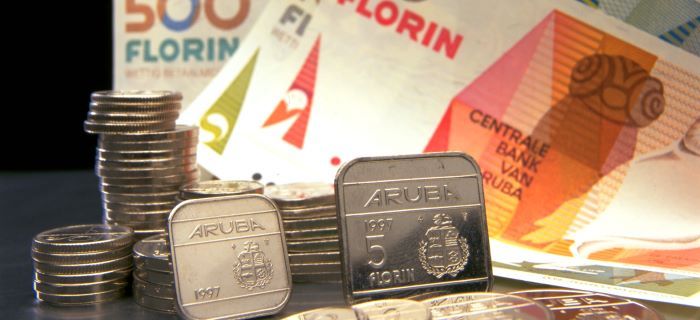
°F - °C more weather...
Live Webcams
- Popular Links:
- Optima Car Rental Aruba
- Horseback Riding
- MVC Eagle Beach
- Amsterdam Manor Beach Resort
- Aruba Vacation Deals
- Print this page
- ATM & Banks
- Internet Access / WiFi
- Currency - Exchange Rates

Aruba Currency
Aruba's currency is the florin denoted by the letters "Awg." but also widely known as "Afl.". The official rate at which banks accept US dollar banknotes is Awg. 1,77 and checks at Awg. 1,78. The rate of exchange granted by shops and hotels ranges from Awg. 1,75 to Awg. 1,80 per US dollar. US Dollars are widely accepted in Aruba, and banks may exchange other foreign currency.
Exchange Rates
Currency converter, travel cheat sheet.
- Travel Checks & Credit Cards
- AWG = Aruban Florin
- USD = US Dollar
- CAD = Canadian Dollar
- GBP = British Pound
Exchange reference rates as at April 15, 2024
Traveler's checks & Credit Cards
Traveler's checks are widely accepted and there is no charge for using them in hotels, restaurants and stores. Major credit cards, like Visa and MasterCard, are accepted at most establishments while personal checks are normally not accepted.
Cash may be obtained with MasterCard, Visa and American Express cards at credit card offices, banks, in some casinos and via Western Union. Debit cards and credit cards are accepted by ATMs of Aruba Bank, Banco di Caribe, RBTT Bank, and Caribbean Mercantile Bank. The card must have either a Cirrus or Visa Plus logo. ATM instructions are normally given in Dutch, English, Spanish and Papiamento. Cash is normally dispensed in local currency or US Dollar.
- © copyright 1999 - 2024 Aruba Travel Guide / wwtg - all rights reserved
- Terms of use
- Privacy Policy
Page not translated
The exact page you are looking for has not been translated.
Confirm Selection
This site uses cookies. Some are essential while others improve your browsing experience and allow us to advertise. For more info visit the privacy policy page.
Allow inessential cookies for:
Your preferences have been updated.
Aruba Currency
The official local currency is the Aruban Florin; however, U.S. dollars are widely accepted.
What currency does Aruba use?
The currency on the island is the Aruba Florin. You can exchange U.S. dollars, but it isn’t necessary. Using American money in Aruba is common and widely accepted. You may receive Aruba currency as change.
What is the currency exchange rate in Aruba?
The Aruba currency exchange rate for U.S. dollars is Afl 1.77 for cash and Afl 1.78 for traveller’s checks. Most supermarkets and gas stations use the exchange rate of Afl 1.75, while many restaurants and shops use the exchange rate of Afl 1.80.
Credit cards and ATM machines
All major credit cards and traveler’s checks are accepted. Personal checks from abroad are generally not accepted.
*Please note, some businesses will not accept U.S. $50 or U.S. $100 due to worldwide counterfeiting.
ATM cards with a Cirrus, MasterCard, Maestro, or Visa logo can withdraw cash at banks and more than 50 locations and ATMs in Aruba.
Banks are generally open from 8 a.m. to 4 p.m., Monday through Friday, though some branches remain open later on Friday and on Saturday morning.
Don’t forget to contact your credit card provider prior to departure and advise them of your travel plans. Otherwise, overseas charges may be questioned or denied.
Cost of living
If you compare the cost of living in Aruba to the U.K., it is quite similar. Groceries are a bit more expensive, since agriculture in Aruba is limited and almost all food needs to be imported. Prices are 5 to 6% higher. Eating out is cheaper than in the U.K. Prices are about 11% lower. Tipping in Aruba is not mandatory. If you feel like leaving a tip, the amount is entirely up to you.
Aruba is a virtual nirvana for shoppers , with a greater selection of international brand name products than anywhere else in the Caribbean or South America, and prices that are 10% - 35% lower than in the United States!
Turtle Nesting Season
How to protect our sea turtles during your holiday.
Volunteers from Turtugaruba devote many hours watching over, protecting the nests and educating us during the season.
The official currency in Aruba is the Aruba florin. If you’re traveling with U.S. Dollars, Aruba currency exchange will not be necessary; however, you may receive Aruba money as change when paying with U.S. Dollars. This is not a problem, simply spend the Aruba money first and take the remainder of your U.S. Dollars home. You will always be aware of what you’re spending because the Aruba currency exchange rate is fixed and easy to calculate. Just keep the following numbers in mind when calculating the amount of Aruba money to USD: Afl 1.77 for cash and Afl 1.78 for traveller’s checks. Most supermarkets and gas stations use the exchange rate of Afl 1.75, while many restaurants and shops use the exchange rate of Afl 1.80.
Banks and ATMs in Aruba can be found all over the island at more than 50 locations. If you have an ATM card with a Cirrus, MasterCard, Maestro, or Visa logo, you can withdraw cash without any problems.
Go for an Aruba All-Inclusive Vacation
Stay, play and indulge to your heart’s content at one of Aruba’s beautiful all-inclusive resorts.
Sightseeing Tours in Aruba
The only thing easier than navigating our happy island is letting a local show you around the Aruba they know and love.
Featured Products
The mask aruba, eating and drinking, sopranos piano bar, eva boutique.

Start booking your trip to Aruba
- Deals and Offers
Check-in Check-out Search
Depart on Return on Select 1 Adult 2 Adults 3 Adults 4 Adults 5 Adults 6 Adults 7 Adults 8 Adults 9 Adults Passengers City of Origin or Airport Search
Arrival Departure Search
From To Search
We’re just getting started with the amazing effects Aruba has to offer. Dig into your trip details below to unlock a Caribbean experience that will leave you sunnier, happier, and (of course) a little more tanned.
Discover the Aruba Effect
Nomadic Matt's Travel Site
Travel Better, Cheaper, Longer
Aruba Travel Guide
Last Updated: August 30, 2023
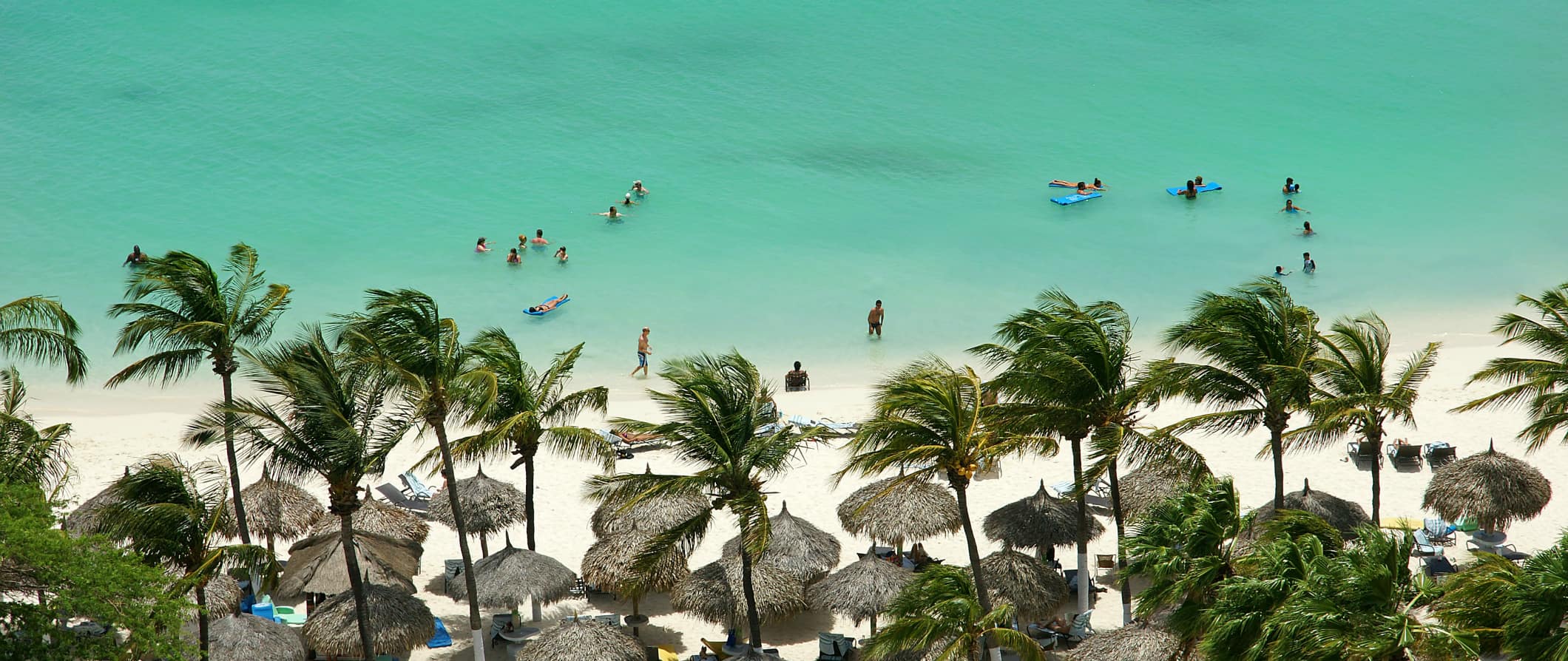
Located in the Netherlands Antilles, Aruba is home to white sandy beaches, crystalline waters, colorful fish, and picturesque ocean views. It’s one of the most popular tropical getaways in the world and a favorite of travelers who visit the Caribbean.
Here you’ll find pastel-colored Dutch houses juxtaposed against the natural island backdrop, transporting you to a tropical version of Amsterdam. Aruba’s not limited to the beaches and towns, though. Since it doesn’t get a ton of rain, the arid landscape has huge boulders and cactus forests scattered across it.
Like most other Caribbean islands , Aruba is expensive. This is a destination where honeymooners and luxury travelers go to relax so you’ll pay a premium for hotels, food, and activities in Aruba.
That doesn’t mean it’s impossible to visit Aruba on a budget though — it just takes some planning.
But, no matter your budget, this Aruba travel guide has all the practical information you need to help you plan your visit so you can make the most of your time in this island paradise!
Table of Contents
- Things to See and Do
- Typical Costs
- Suggested Budget
- Money-Saving Tips
- Where to Stay
- How to Get Around
- How to Stay Safe
- Best Places to Book Your Trip
- Related Blogs on Aruba
Top 5 Things to See and Do in Aruba
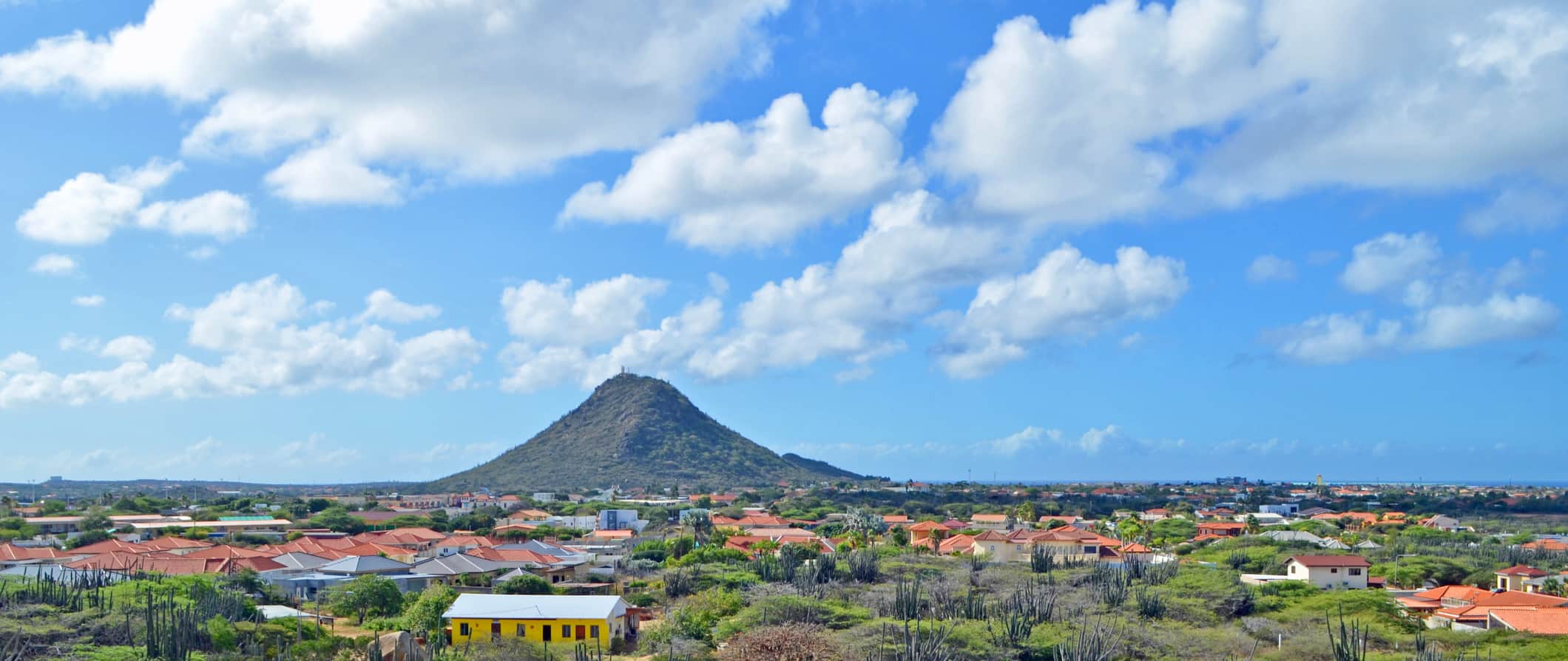
1. Go Snorkeling
Snorkeling is the number one thing to do on the island . The shores are filled with brightly colored coral, angelfish, clownfish, and even the occasional octopus. Many hotels offer their guests free use of snorkeling equipment (feel free to pack your own though). Arashi Beach is best for beginner swimmers because of its shallow waters and sandy bottom, but a popular stop for snorkeling tours is Boca Catalina and its neighbor to the north, Catalina Cove, for the plentiful fish and wide variety of sea life. Expect to pay at least 100 AWG per person for a two-hour guided snorkeling trip.
2. Explore Oranjestad
Aruba’s capital city is styled in Dutch architecture, with homes featuring curved roofs and plenty of pastel colors. Named after the Prince of Orange, here you can hop on and off the free streetcar which runs through the downtown area, home to the shopping district, as well as the National Archaeological Museum (free entry) and the Historical Museum of Aruba (9 AWG). Don’t miss Fort Zoutman, built by African slaves in the 18th century.
3. Sail around
Sailing is very popular and you can find snorkeling, sunset, dinner, and party cruises here on anything from small catamarans to big pirate ships. Depending on your budget, you can opt for a more inclusive cruise like The Tranquilo, which comes with refreshments and lunch for 180 AWG. Pelican Adventures offers a more basic 2.5-hour snorkeling cruise for 105 AWG.
4. Go diving
Aruba has lots of dive sites, including the Antilla wreck, a German ship that was scuttled at the outbreak of World War II, as well as sunken airplanes just off Renaissance Island. There are all kinds of wildlife to be seen, including stingrays, moray eels, yellowtail snappers, and more. Not a certified diver? There are plenty of options for introductory diving courses as well if you want to test the waters. Single-tank dives start from 155 AWG.
5. Hike Hooiberg
Also known as Haystack Mountain, Hooiberg stands over 500 feet tall in the center of Aruba and is the perfect lookout for panoramic views over the island. On a clear day, you can see the coast of Venezuela! Bring lots of water and a hat as it’s a steep climb to the top (587 steps to be exact!), and don’t be surprised if you run into a few goats on your way up. It is recommended to do this hike early in the day or late in the afternoon to avoid the heat.
Other Things to See and Do in Aruba
1. relax on a beach.
Aruba’s powdery soft beaches and clear waters make for excellent days full of sunbathing, snorkeling, and swimming. Eagle Beach is the most popular, and its wide stretches of sand mean it’s never too crowded. Then there’s Flamingo Beach on Renaissance Island, where you can hang out with actual flamingos; or Drulf Beach, which is easily accessible from Oranjestad. If you want more solitude and quiet, head to Andicuri Beach, where rocky cliffs frame a wide swath of beachfront extending into the turquoise sea. There’s also Boca Prins Beach, which can be found in Arikok National Park (it has incredible views but watch out for the strong waves).
2. Go kayaking
For a relaxing way to explore Aruba’s coast, hop in a kayak. Most hotels offer their guests free use of kayaks. Otherwise, expect to pay around 45 AWG per hour for a rental. The coastline has a lot of little coves to explore, so take your time. Conversely, you can take a tour with Clear Kayak Aruba. Their clear-bottomed kayaks let you see the reefs and coral beneath you. A two-hour guided paddle costs 120 AWG for the daytime tour and 270 AWG for the night tour.
3. Rent a quad
A quad (ATV) lets you get off the beaten track and explore some of the smaller beaches and jungles on the island. While getting a guide is the best option, you can also explore the island on your own. A half-day quad rental is 199 AWG, while it’s 229 AWG for the full day. Tours start from 215 AWG per person.
4. Go golfing
Expensive holiday resorts and golf go hand in hand. Unfortunately, golf here isn’t a budget-friendly activity. If you want to hit the links, expect to pay 160-300 AWG per round at the island’s championship course, Tierra Del Sol. Its gorgeous 18-hole course is right on the ocean. Another option is The Links at Divi Aruba, where you can get in a quick 9 holes for 162 AWG (club rentals are available for an additional fee).
5. Visit the Archaeological Museum
Aruba has a complex history as it has been invaded by several colonial powers throughout the centuries. This former family home has been transformed into a museum displaying a variety of stone, shell, and ceramic artifacts from Aruba’s distant past, dating all the way back to 2,500 BCE. If you want a better understanding of the island’s long history, stay and watch the documentary film on ancient indigenous life. Admission is free.
6. Find tranquility at the Peace Labyrinth
The Peace Labyrinth sits atop a bluff overlooking the Caribbean. Next to a small chapel, here you can walk mindfully through the intricate outdoor labyrinth of stone, which is meant to serve as a sort of meditation. The entire Labyrinth fell into disrepair in recent years, but in 2019 volunteers gave it an overhaul so it looks great again. The grounds are free to wander.
7. Visit the Donkey Sanctuary
Once a major mode of transportation, donkeys have lived on the island of Aruba for over 500 years. After cars arrived, donkeys became less needed and their population hit record lows. Now, donkeys live primarily in this non-profit sanctuary. It’s a fun place to spend the afternoon, especially if you have kids, as you’re invited to feed and care for the donkeys (no riding is allowed). Admission is free, but donations are welcome.
8. Visit the Collapsed Natural Bridge
Once extending over 100 feet across and 25 feet high, this “bridge” was naturally carved into the coral limestone by the sea until it collapsed in 2005. It’s still a top-rated tourist attraction, serving as a scenic viewpoint and lookout, and can be accessed by car via a dirt road. Nearby is the “Baby Bridge” that still stands, which is also recommended to check out while you’re in the area.
9. Take a jeep tour
One of the best ways to view the island is by taking a 4×4 tour that allows you to see parts of Aruba that lie off the beaten track, including the rugged north coast. There are several different tour options that offer an adrenaline rush as you tear up the backcountry, pause to visit caves and go for a swim and explore hidden beaches. Jeep tours start from 150 AWG.
10. Explore Arikok National Park
Located in the northeastern part of the island, you can find most of Aruba’s flora and fauna in Arikok National Park. At 34 square kilometers (13 sq mi), it makes up around one-fifth of Aruba and has lots of different geological features, including volcanic hills and limestone rocks formed from fossilized coral. The park has a couple of stunning beaches, as well as Conchi, a natural pool that’s only accessible on foot, on horseback, or in a 4×4. Arikok is also home to Cunucu Arikok and Fontein Cave, where you can see rock paintings left behind by the indigenous Caquetío. A day pass costs around 20 AWG.
11. Climb California Lighthouse
You can get amazing views of the west coast beaches and the coral shorelines from the top of this lighthouse. It was named after the S.S. California, which sunk before the lighthouse was built in 1910. It’s located in the northwest of Aruba in the area known as “Hudishibana.” Go at dusk for one of the best sunsets on the island. Admission is 9 AWG.
For information about other Caribbean destinations, check out these guides:
- British Virgin Islands
- Saint Lucia
Aruba Travel Costs
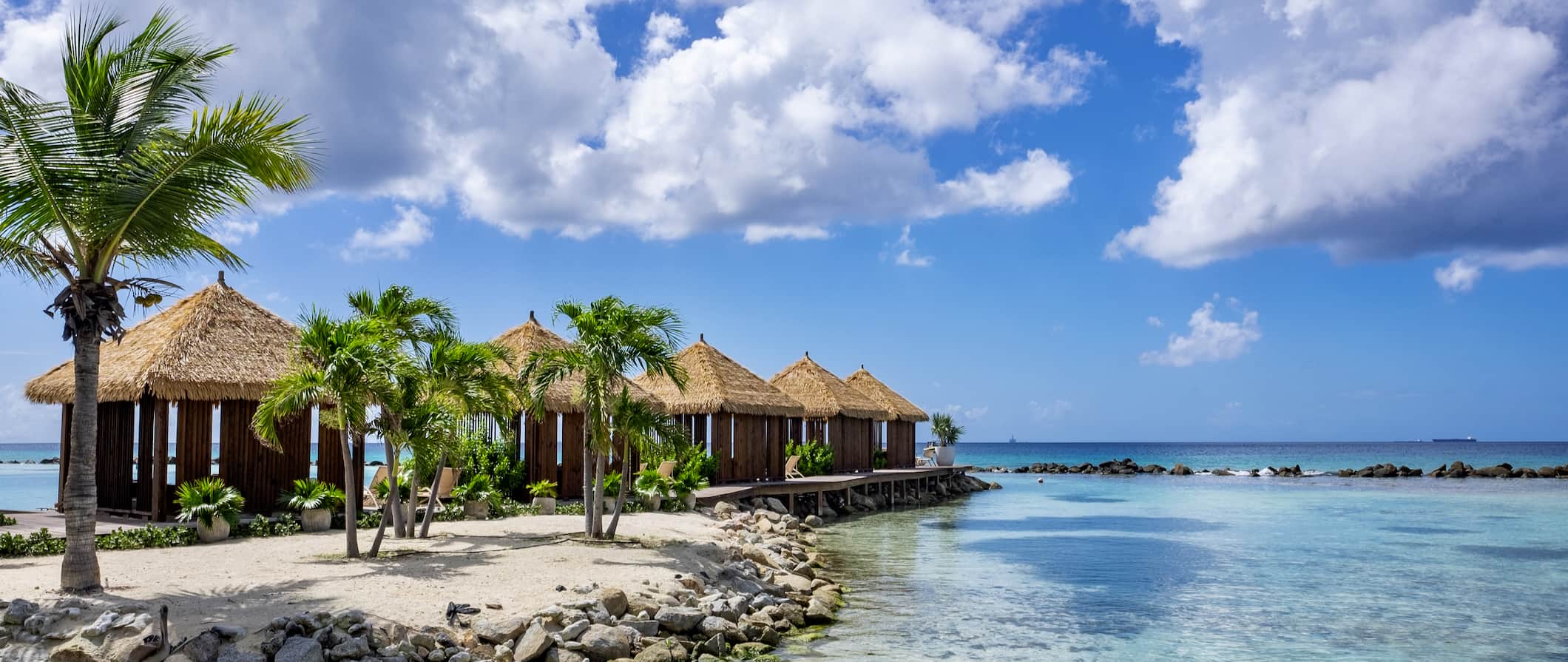
Camping is not available in Aruba.
Budget hotel prices – Budget two- and three-star hotels start at 170 AWG in Oranjestad but are closer to 225 AWG near beach resort areas. Free Wi-Fi is standard and many budget hotels also have pools. Some even include free breakfast.
On Airbnb, private rooms start at 80 AWG per night while entire homes/apartments average closer to 400 AWG per night. Be sure to book early to find the best deals as prices can double when not booked in advance.
Food – The cuisine in Aruba is a mix of Dutch, Caribbean, and South American flavors. Seafood, of course, is king, with mahi-mahi, red snapper, and grouper all being commonly caught around the island. Fresh fruit is also super popular. Be sure to try cool soup (a cold soup made from fruits), sopi mondongo (a stew made with tripe or bone marrow), cala (a spicy fried snack), and fried plantains.
For a casual seafood meal at a restaurant, expect to pay around 30 AWG. For fast food (think McDonald’s), a combo meal costs around 17 AWG. Chinese food on the island averages around 25 AWG per person for a plate and drink, compared to a pizza which costs around 45 AWG for a large.
If you want to splash out, a mid-range three-course meal with a drink costs around 90 AWG (upscale places cost upwards of 100 AWG).
Beer is 8-9 AWG while a latte or cappuccino is 6 AWG. Bottled water costs around 2-3 AWG.
If you plan on cooking your own food, a week’s worth of groceries costs around 130 AWG. This gets you basic staples like rice, pasta, seasonal produce, and some meat or seafood. Be sure to do your shopping at large supermarkets as opposed to mini-marts, as they tend to overcharge for convenience.
If you get a chance, order seafood at Zeerovers. It’s delicious!
Backpacking Aruba Suggested Budgets
If you’re backpacking Aruba, my suggested budget is 145 AWG per day. This assumes you’re staying in a hostel or cheap Airbnb, cooking all of your meals, limiting your drinking, taking the bus to get around, and doing mostly free activities like swimming and relaxing on the beach. If you plan on drinking, add another 10-20 AWG to your daily budget.
On a mid-range budget of 300 AWG per day, you can stay in a private Airbnb or budget hotel, eat out for a couple of meals, enjoy some drinks, take the occasional taxi to get aroundm and do some paid activities like diving or a snorkeling tour.
On a “luxury” budget of 560 AWG or more per day, you can stay in a hotel, eat out for all your meals, drink as much as you want, rent a car or quad to get around and do whatever tours and activities you want. This is just the ground floor for luxury though. The sky is the limit!
You can use the chart below to get some idea of how much you need to budget daily, depending on your travel style. Keep in mind these are daily averages — some days you’ll spend more, some days you’ll spend less (you might spend less every day). We just want to give you a general idea of how to make your budget. Prices are in AWG.
Aruba Travel Guide: Money-Saving Tips
Aruba caters to vacationers and luxury travelers, so there are not a ton of options here for cutting your budget. Here are the few ways you can save money in Aruba:
- Eat local fish – You’re on an island, so local specialties such as grouper, mahi-mahi, and snapper are less expensive than other seafood options (plus, they’re fresh)! Avoid anything that is imported.
- Enjoy nature – Relax on the beach, go for a hike, or take in a sunset. Aruba’s natural beauty is breathtaking — and free!
- Book online – If you’re planning on going diving, or doing any other expensive activities, be sure to check online for discounts before. Some companies offer discounts for direct bookings.
- Stay with a local – There isn’t a huge Couchsurfing scene here but if you can find a host that can let you stay for free you’ll be able to cut your costs drastically. It’s a great way to meet locals too!
- Bring a water bottle – The tap water here is safe so bring a reusable water bottle to save money and reduce your plastic use. LifeStraw is my go-to brand as their bottles have built-in filters to ensure your water is always clean and safe.
- Cook your own food – Eating out adds up, so book accommodation with a kitchen so you can buy groceries and cook your own meals. It won’t be luxurious but it will be cheaper!
Where to Stay in Aruba
Budget accommodation is limited here so be sure to book early. Here are my suggested places to stay in Aruba (all located in Oranjestad) are:
- Hostel Room Aruba
- Aruba Harmony Hostel
How to Get Around Aruba
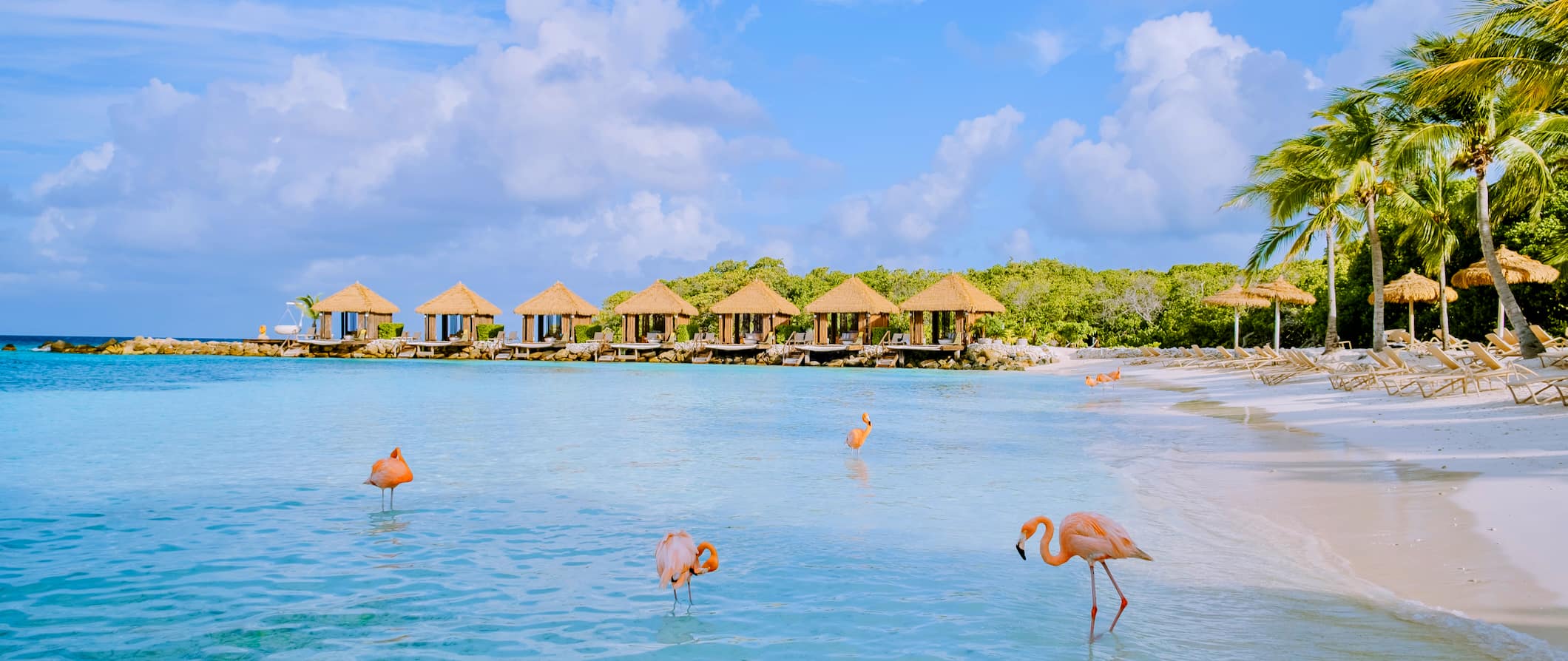
Public transportation – Arubus is the public bus in Aruba, and it gets you everywhere you need to go. Their website, Arubus.com, has a full list of schedules and routes. You can purchase a return ticket for 8.75 AWG, or an unlimited day pass for 17.50 AWG. You pay the driver when you board.
Oranjestad has a free open-air trolley that runs the length of downtown’s main street. It runs every 25 minutes between 10am-5pm. Expect the trolley to be busy on days that cruises come to port.
Taxis – Taxis in Aruba are safe and reliable, but they do not have meters as rates are set by the government. Because of this, there is no ride-shares (like Uber) available on the island. The minimum fare is 12.60 AWG, but you should ask your driver beforehand what the total amount will be.
Car rental – Cars can be rented here for around 75 AWG per day for a multi-day rental. You don’t need an International Driving Permit (IDP) to rent a car here but drivers must be at least 21 and have had their license for two years. For the best prices, use Discover Cars .
When to Go to Aruba
Peak season is January to March when temperatures average in the high 20s°C (mid-80s °F). Expect room prices to soar and for the island to be full and lively.
Personally, I think April to August is the best time to visit Aruba, as this is considered the off-season and prices decrease during this time (there are fewer tourist crowds also). Aruba isn’t part of the Caribbean’s hurricane belt, so there’s not much risk of tropical storms either. Temperatures average around 32°C (90°F).
Fortunately, Aruba is usually pretty breezy, so there’s some relief from the humidity.
How to Stay Safe in Aruba
Aruba is considered one of the safest places to visit in the Caribbean as it’s a small island with a low crime rate. However, it’s still best to not leave your valuables out and unattended at the beach (or anywhere) to avoid petty theft as you would anywhere really!
The San Nicolas area is best avoided at night if you’re alone.
Solo female travelers should feel safe here for all those reasons. However, the standard precautions you take anywhere apply here too (never leave your drink unattended at the bar, never walk home alone intoxicated, etc.). There are numerous solo female travel blogs that can provide more specific tips.
When in the water, be mindful of strong currents. Avoid swimming and other water activities on the northern end of the island for this reason.
Scams here are rare, but if you’re worried about getting ripped off, you can read about common travel scams to avoid right here.
If you experience an emergency, dial 911 for assistance.
Remember to always trust your gut instinct. Avoid isolated areas at night, and be aware of your surroundings at all times. Make copies of your personal documents, including your passport and ID.
The most important piece of advice I can offer is to purchase good travel insurance. Travel insurance protects you against illness, injury, theft, and cancellations. It’s comprehensive protection in case anything goes wrong. I never go on a trip without it as I’ve had to use it many times in the past.
Aruba Travel Guide: The Best Booking Resources
These are my favorite companies to use when I travel. They consistently have the best deals, offer world-class customer service and great value, and overall, are better than their competitors. They are the companies I use the most and are always the starting point in my search for travel deals.
- Skyscanner – Skyscanner is my favorite flight search engine. They search small websites and budget airlines that larger search sites tend to miss. They are hands down the number one place to start.
- Hostelworld – This is the best hostel accommodation site out there with the largest inventory, best search interface, and widest availability.
- Booking.com – The best all around booking site that constantly provides the cheapest and lowest rates. They have the widest selection of budget accommodation. In all my tests, they’ve always had the cheapest rates out of all the booking websites.
- Get Your Guide – Get Your Guide is a huge online marketplace for tours and excursions. They have tons of tour options available in cities all around the world, including everything from cooking classes, walking tours, street art lessons, and more!
- SafetyWing – Safety Wing offers convenient and affordable plans tailored to digital nomads and long-term travelers. They have cheap monthly plans, great customer service, and an easy-to-use claims process that makes it perfect for those on the road.
- LifeStraw – My go-to company for reusable water bottles with built-in filters so you can ensure your drinking water is always clean and safe.
- Unbound Merino – They make lightweight, durable, easy-to-clean travel clothing.
- Top Travel Credit Cards – Points are the best way to cut down travel expenses. Here’s my favorite point earning credit cards so you can get free travel!
Aruba Travel Guide: Related Articles
Want more info? Check out all the articles I’ve written on backpacking/traveling the Caribbean and continue planning your trip:
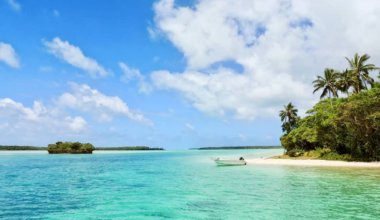
9 Ways to Explore the Caribbean Sustainably
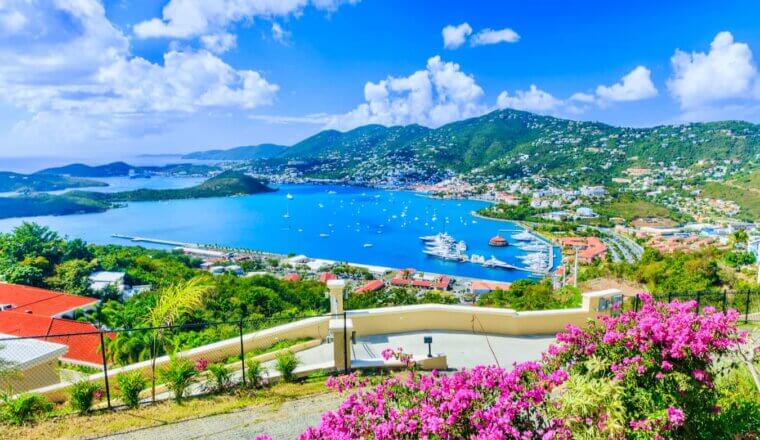
My 16 Favorite Things to Do in the Virgin Islands
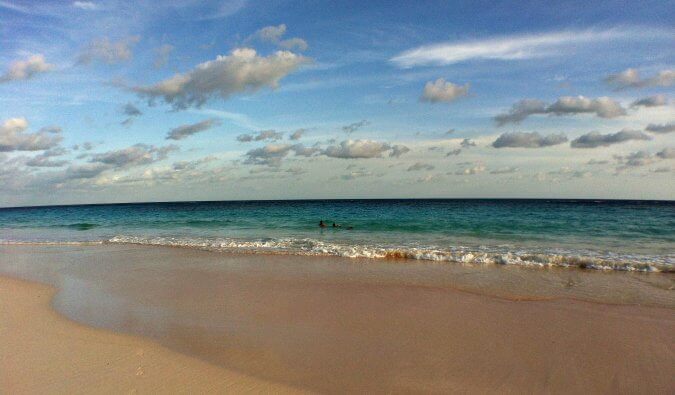
Bermuda: The Impossible Budget Destination? Maybe Not!
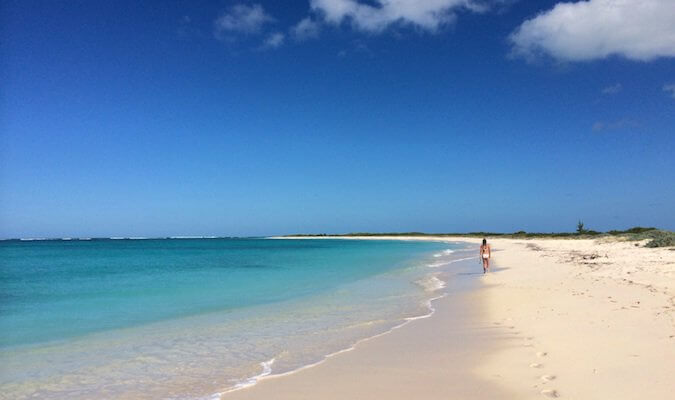
How to Save (and Not Save) Money in the Virgin Islands
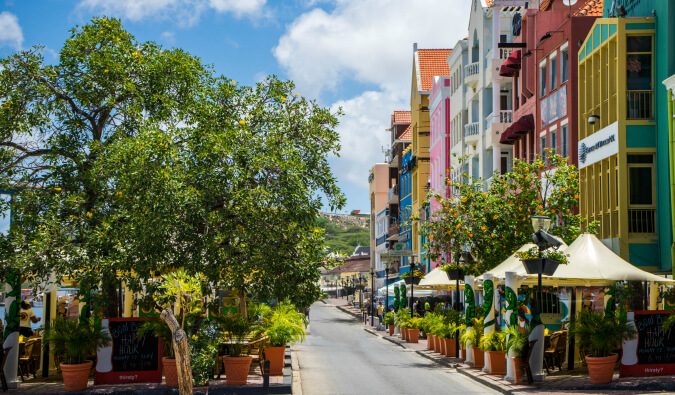
I Didn’t Like Curaçao (But I Didn’t Hate it Either)
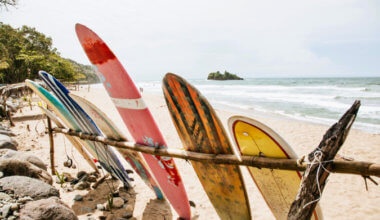
The Best Places on Costa Rica’s Caribbean Coast
Get my best stuff sent straight to you, pin it on pinterest.
- Where To Stay
- Transportation
- Booking Resources
- Related Blogs

Aruba Currency: Everything you need to know
Come to aruba, but come prepared.
One of the main things you need to take care of when coming to the island is converting your money. Here are a few things you need to know about Aruba currency and how you can manage it during your trip.
Download our Handy Guide to live Aruba as a Local
The currency of Aruba is the Aruban Florin , denoted by the symbol “AWG.” The Aruban Florin is the official Aruba currency and is widely used for cash transactions on the island. However, the Aruba currency to US dollar (USD) is also accepted and circulated , and many businesses accept it.
The Aruba currency exchange rate between the Aruban Florin and the US dollar is fixed at approximately 1 USD = 1.75 AWG. This fixed exchange rate has remained stable for many years.
However, it’s important to note that some businesses and vendors may offer a less favorable exchange rate for US dollars compared to official exchange outlets, so it’s advisable to check the rates and compare before making currency exchanges.
Acceptance of other currencies
While the Aruban Florin is the local currency, major credit cards are widely accepted in hotels, restaurants, and larger establishments . ATMs are also available across the island. This allows you to withdraw local currency using your debit or credit card.
If you plan to visit Aruba, it’s a good idea to have a mix of US dollars and Aruba currency for your convenience. Small denominations and coins are particularly useful for everyday purchases, transportation, and tipping.
Additionally, it’s recommended to notify your bank or credit card company about your travel plans to ensure smooth usage of your cards and to inquire about any potential foreign transaction fees or card restrictions.
Where to exchange your money
Most banks on the island offer Aruba currency exchange services. Some of the major banks include Aruba Bank, Banco di Caribe, and RBC Royal Bank.
Currency Exchange Offices
There are several offices in popular tourist areas, such as Oranjestad and Palm Beach , that will provide you with the Aruba Currency . These offices often offer competitive rates. Look for signs indicating “Currency Exchange” or “Cambio” to locate these establishments.
Automated Teller Machines (ATMs) are widely available in Aruba . They allow you to withdraw Aruba currency using your debit or credit card. ATMs usually provide a competitive exchange rate, and y ou may incur foreign transaction fees or ATM withdrawal fees, depending on your bank or card issuer.
Approximate Costs to Cover
Depending on your bucket list of choice, you should come prepared to spend some Aruba money in a couple of essentials. We’re breaking it down to make your job easier:
Car Rentals
If you’re looking to have a car at your disposal throughout your whole trip , you can set that up at Expedia . Prices range between $35 to $330 per day, depending on how luxurious the vehicle is.
However, by staying at Ocean Z , you’d be so close to all the popular spots on the island that you could take a quick shuttle to anywhere you need to be.
Sunset Cruises
Depending on the feature s they include, the tours tend to last around 2 to 3 hours. Also, they may include open bars that serve alcoholic and non-alcoholic beverages, light snacks, and sometimes live music or entertainment.
Prices for standard sunset cruises in Aruba can range from approximately $40 to $80 per person.
If you’re looking for a more upscale experience , there are luxury sunset cruises featuring gourmet dining, premium drinks, and a more intimate setting. These range between approximately $100 to $200 or more per person.
Ocean Z Restaurant
Our top restaurant picks for your trip is, of course, Ocean Z Restaurant . Apart from being extremely close to your suite , we have a carefully created array of seafood and international cuisine dishes waiting for you to delight your taste buds.
The prices range from $17 to $70 , and our services feature dinner under the stars, live music, intricate customer service, an open bar every night, and so forth.
Water Sports
Another staple in your Aruba trip has to be water activities . There’s something suitable for each type of person. The prices for water sports in Aruba can vary depending on the specific activity, duration, equipment rental, and the operator or tour company:
If you prefer Snorkeling because of its tranquil nature, gear rentals typically range from $10 to $20 per day. Guided tours with transportation usually range between approximately $30 to $60 per person.
Also, Aruba offers excellent scuba diving opportunities with various dive sites, including reefs, shipwrecks, and coral formations. Prices for a single-tank dive can range from approximately $50 to $100.
If you rather go on more adrenaline-pumping endeavors, you need to try jet skiing. This thrilling water sport ranges from around $60 to $100 per half-hour or hour, depending on the duration and type of jet ski.
There’s also Parasailing, which provides you with a unique perspective of the coastline as you soar above the water. Prices for these experiences typically range from approximately $50 to $100 per person.
Get your budget and go!
These tips will get you more than ready for your trip to the island. You’ll live the experience as a visitor, but know the logistics like a local. Don’t miss out on the holiday of a lifetime and discover Ocean Z Aruba and all the wonders of this happy island. It’s that easy!
Don’t miss out on our quick guide full of traveling tips for you when you visit Aruba. This handy little blueprint will show you a couple of hacks to make your trip more enjoyable and worthwhile.
Submit a Comment Cancel reply
You must be logged in to post a comment.
Ready for your next post?

The best things to do in Aruba for couples in 2024
Apr 16, 2024
The best things to do in Aruba for couples in 2024 Pristine beaches and breathtaking sunsets are the perfect destination for couples looking to escape the ordinary and create unforgettable memories together. If you're seeking the ultimate romantic getaway, look no...
Privacy Overview
Master king ocean view suite.
With added room with 2 twin beds + Semi Private Pool. (484 ft 2 ) (Room Capacity: 4)

In-room Specials
- ﹥ Housekeeping
- ﹥ Personal Safe
- ﹥Air conditioning
- ﹥ LCD flat Smart TV 48”
- ﹥ Bose alarm clock with bluetooth
- ﹥ Customized Robes and slippers
- ﹥ Luxurious Bathroom
- ﹥ Showers with private outdoor deck
- ﹥ Deluxe SPA Bvlgari Toiletries
- ﹥ Personalized attention
- ﹥ Breakfast is Included with your stay
- ﹥ Elegant tote bags for pool
Hotel’s Accommodations
- ﹥ Breakfast included in room price
- ﹥VIP reception and assistance
- ﹥Gourmet restaurant with breakfast served as desired.
- ﹥ Lounge Bar, Philippe Starck designed Kong chairs
- ﹥Wireless Internet Access
Mini Master King
Pool View with One King Bed (Extra Twin Bed optional) (226 ft 2 ) (Room Capacity: 2)

Master King Ocean View + an extra room with 2 twin beds
With Semi Private Infinity Pool and Hydrotherapy Jets (592 ft 2 ) (Room Capacity: 2)

Mini Master Queen
View Room with One Queen Bed (236 ft 2 ) (Room Capacity: 2)

Double Suite
With Two Queen Beds (Extra Twin Bed optional) (463 ft 2 ) (Room Capacity: 4)

- Skip to main content
- Skip to primary sidebar
Beyond Borders
A Guide to the Aruban Florin, Aruba’s Currency
World Currencies
Aruba is a Caribbean island country located just north of the South American coast. If you’re intending to live in Aruba or visit there, then you’re going to want to learn about Aruba’s currency, so you can easily pay for goods and services while you’re there.
The official currency of Aruba is the florin, but you can use U.S. dollars (USD) almost anywhere on the island at a fixed exchange rate .

Here’s our guide to Aruba’s currency, including how to exchange USD for florin and whether it’s better to pay using the local currency or the U.S. dollar.
The history of Aruban currency
People have lived on the island of Aruba for thousands of years . From the 1600s to the 1800s, the Spanish, Dutch, and British all occupied it for various periods of time. For the majority of that time, it has been part of the Kingdom of the Netherlands , along with two neighboring islands, Bonaire and Curaçao.
Although Aruba became mostly autonomous in 1986, it has never completely declared independence, and citizens of Aruba are still Dutch nationals.
As for currency, Aruba used the Netherlands Antillean guilder for many years. It shared this currency with other Dutch territories in the Caribbean Sea between 1828 and 1986. Then, it introduced its own version of the currency, the Aruban florin.
The Dutch word for this unit of currency is “gulden,” while the word “florin” comes from the local Papiamento language.
As a result, the florin is sometimes called the “Aruban guilder.” The Central Bank of Aruba uses both the abbreviation “Afl” (for florin) and the currency code “AWG” (for guilder) to refer to Aruban currency.
Aruba currency denominations
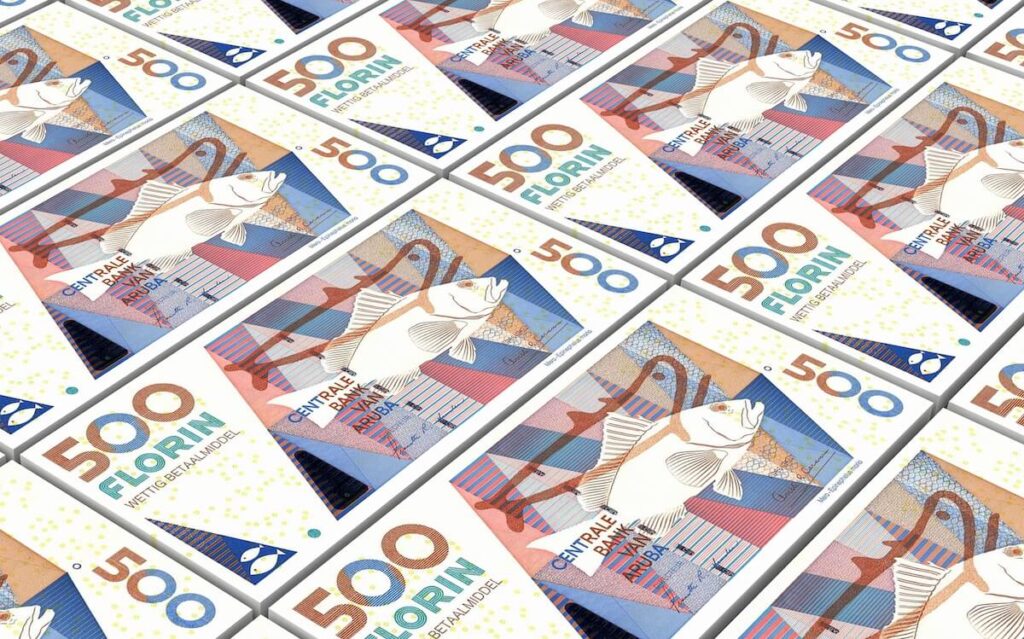
The Aruba florin comes in multiple coin and banknote denominations, with each florin subdivided into 100 cents. You can use a lowercase “ f ” for florin and ¢ for cents.
Florin banknotes are bright and colorful, featuring native animals like the rattlesnake, frog, turtle, and owl. You’ll find banknotes in the following denominations:
The International Banknote Society chose the 100-florin as the “ Banknote of the Year ” in 2019. It praised the “new vertical format,” as well as the “beautiful artistic elements from Aruban culture” and advanced security features to prevent counterfeiting.
Coins come in the following denominations:
There’s also a 2½-florin coin, but it’s no longer in production. Some coins feature the Dutch phrase “ God Zij Met Ons ,” which translates to “God Be With Us.”
5 essential facts about Aruba’s currency
Since visitors to Aruba can spend the U.S. dollar, many visitors miss out on using this beautiful currency themselves. Whether you choose to convert your USD or not, here are five key facts to help you understand more about Aruba’s currency.
1. Aruba’s currency is pegged to the U.S. dollar.
The Aruban florin has a fixed exchange rate with the U.S. dollar, meaning 1 USD will be worth the same amount of florin no matter when you travel there. This is in contrast to free-floating currencies that fluctuate over time .
The current exchange rate is set at 1 USD = 1.79 florin (or 1 AWG = 0.56 USD), but you may get a slightly different rate depending on where you shop.
2. Aruban currency features Dutch royalty.
Because Aruba is still part of the Kingdom of the Netherlands, you’ll notice some Dutch influences on Aruba currency. The most obvious is the appearance of Dutch royalty on some coins—but not on any banknotes.
Until 2013, Queen Beatrix appeared on the five-florin coin and two other denominations. After her abdication, her son, King William-Alexander, took her place.
3. Some of Aruba’s coins are square.
Some of Aruba’s coins have a surprising characteristic: They’re square. Although round coins make up the majority of the world’s coinage, the 50-cent coin (called a “ yotin ”) is square-shaped. So is the 2½-florin coin, which is now primarily a collector’s item.
4. You can’t spend the Netherlands Antillean florin (NAf) here.
Two nearby countries, Curaçao and Sint Maarten, use the Netherlands Antillean florin (or guilder). It uses the symbol NAf and the currency code ANG.
Although it shares a history (and a name) with the Aruban florin, these aren’t the same currency, so you can’t spend NAf in Aruba and vice-versa.
5. Aruba’s GDP is one of the highest in the region.
The cost of living in Aruba is one of the highest in the Caribbean—but so is its GDP per capita. As of 2021, it was around 51,000 florins , or just over $28,000 USD.
Aruba’s economy revolves around tourism, and its capital, Oranjestad, is the financial center of the island. That’s where the Central Bank of Aruba is located.
Understanding and using Aruban money
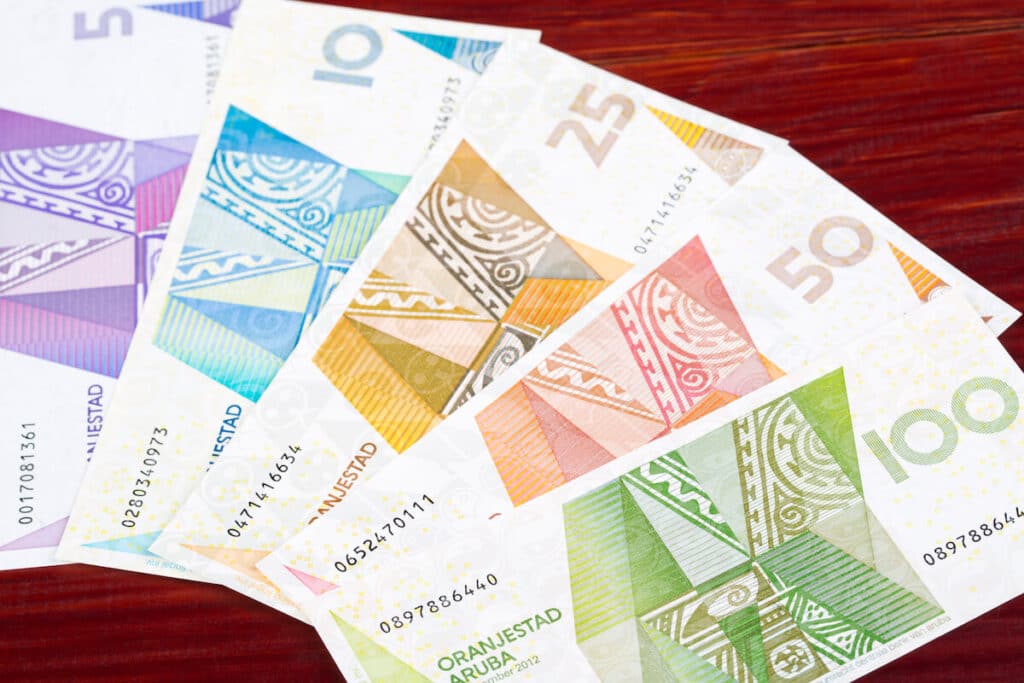
If you’re heading to Aruba, you’ll need to be prepared to carry cash. You can use major credit cards—especially Visa and Mastercard—at most retailers, but small businesses, such as taxis and roadside vendors, may only accept cash.=
Still, you’ll usually have the choice between two currencies: Aruba’s currency, the florin, and the U.S. dollar.
If you need to use an ATM, you’ll find them in many hotels and tourist areas, and you can expect withdrawal fees of around 2 Afl .
Try to have small bills and coins on hand. Aruba has a strong tipping culture , even if a service charge is already included.
Aruba currency exchange rates
The exchange rate between Aruban currency and the U.S. dollar is fixed, so you don’t have to worry too much about shopping around for the best rate. Still, it’s a good idea to get familiar with the USD to AWG exchange rate, that way you can quickly understand the cost of items, and ensure that you’re getting the correct change.
Of course, if you’re converting your money from another currency, such as the euro or the Indian rupee , the exchange rate with the florin will change over time.
You can use an online currency converter to check the current exchange rate between your home currency and the Aruban florin. Then, decide if you want to exchange your money for USD or AWG to spend while you’re in Aruba.
Send money overseas with a mobile app
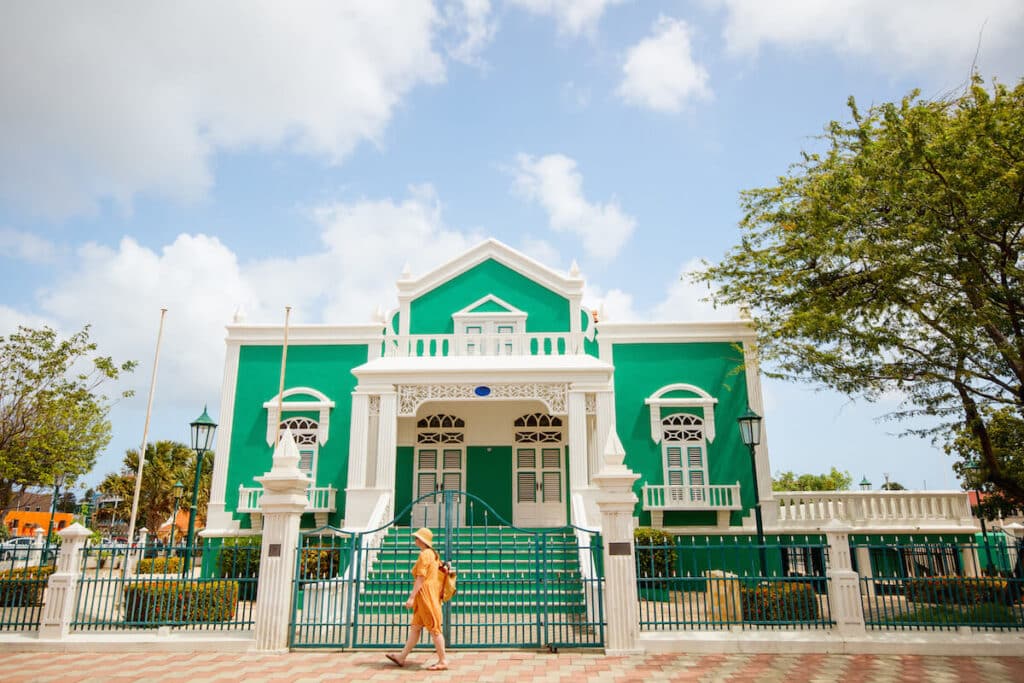
Whether you live in Aruba or are just visiting, being able to transfer money overseas can make travel easier. Fortunately, international money transfers are more convenient than ever and can spare you high credit card fees and ATM withdrawal fees.
Remitly is an international money transfer app with transparent fees and a fair exchange rate. You can fund a transfer with a credit card, debit card, or bank account, and send money to friends and family members, or even to your own international bank account .
Over 5 million people have used Remitly for their international money transfer needs. Download the app today to get started!
Further reading
- What Countries Use Dollars?
- How to Safely Send Money to Jamaica in 4 Easy Steps
- 5 Interesting Facts About Guyana’s Currency (GYD) and Economy

Travel Guide
- Things to Do
- Best Hotels
- Things to See
- Best Restaurants
- Best Nightlife
- Active Pursuits
- Entry Requirements & Customs
- Getting Around
- Tips on Accommodations
- Visitor Information
- Sustainable Travel & Ecotourism
- Health & Safety
- Calendar of Events
- Tips for Families
- Getting There
- Tips for Gay and Lesbian Travelers
- Tips for Senior Travelers
- Tips for Travelers with Disabilities
- Staying Connected
Money in Aruba
Let's face it, Aruba ain't cheap. Well known for its glitzy hotels, exclusive boutique resorts, and over-the-top restaurants, Aruba has few bargains to offer. Keep in mind, everything has to be flown in and almost no food is produced on the island. For this reason, and because it's marketed to an upscale audience, prices are easily on par with those in similarly ranked restaurants in New York or London. Bank machines are readily available in shopping malls, and in addition to a couple of bucks for fees, you will likely pay a currency conversion fee. Banks may have slightly better prices, but since U.S. dollars are widely accepted, if you have these, you are better off using them and asking for dollars back when you are given change.
Aruba is not a bargain shopper's paradise compared to cheaper Caribbean destinations such as Mexico or the Dominican Republic. The upside is that the standard of living among Arubans is fairly high, and the island lacks grim scenes of abject poverty or hopelessness. There are also some easy ways to save cash. While a taxi to the airport or into town will cost you $15 or $20 dollars, you can ride the clean local buses for about AWG 2.25. A cup of coffee may cost you the usual $3 but most hotels have beverage makers and you don't need to use bottled water since the island has some of the cleanest water in the world. While a three-course dinner at even a moderate restaurant (sans alcohol) can set you back $75, the portions are so enormous that you can easily share one appetizer, main course, and dessert between two people and be sated. Most hotel rooms will run you about $150 a night and (way) up, but if you opt for a small inn catering to locals that is a short walk or bus ride to the beach, you can probably find a deal for around $100 a night.
Taxes, Service Charges & Tipping -- Aruba has a 3% sales tax, but it is unclear whether merchants will charge that when you make a purchase or simply incorporate it into their prices, so it's best to ask before you buy. Hotels charge an 11% government tax on rooms, and most routinely add 5% to 7% for "service." A few resorts may also charge an energy surcharge of $7 to $10 per unit per night.
Some, but not all, restaurants charge 10% to 15% for service, but not all of this goes to the service staff. Some restaurants keep a percentage for overhead, while the rest is distributed among all restaurant personnel; so you are generally expected to leave a little extra cash on the table (say 10%). If no charge is included in your tab, leave 15%, or 20% if the service was excellent.
Taxi drivers expect 10% to 15%, and porters should get about $2 per bag. Some of the hotel service charge should trickle down to the chambermaids, but if you're staying in a nice place, leave $2 per day for the housekeeper anyway. For spa treatments, if a service charge is not included, leave 15%.
Cash/Currency
The U.S. dollar is as widely accepted as the Aruban florin (AWG), and most items and services are priced in both currencies.
The AWG is divided into 100¢. Silver coins come in denominations of 5¢, 10¢, 25¢, and 50¢ as well as 1, 2 1/2, and 5 florins. The 50¢ piece, the square yotin, is Aruba's best-known coin. Paper currency comes in denominations of 5, 10, 25, 50, and 100 florins. At press time, the (fairly stable) exchange rate was 1.79 AWG to $1 (1 AWG is worth about US56¢). Hotels, restaurants, and stores accept dollars at rates of between 1.75 and 1.80 AWG; supermarkets and gas stations use a conversion rate of 1.75 AWG to the dollar.
The currency used in the neighboring Dutch islands of Curaçao and Bonaire, the Netherlands Antillean florin (NAf), is not accepted in Aruba.
Note: Since U.S. dollars are accepted almost everywhere in Aruba, prices are quoted in U.S. dollars throughout this guide.
Arm Yourself with Small Bills -- Bring a bundle of small bills (if your currency is American dollars) to make for easy tipping and small purchases. There's no need to bring large sums of cash, unless you're planning to make big purchases and prefer not to use a credit card.
Aruba has plenty of cash machines -- you'll find them at the airport; and there are also locations throughout Oranjestad in Noord, at the Allegro, Holiday Inn, Hyatt, Marriott Playa Linda, and Radisson in the High-Rise area; and at La Cabana in the Low-Rise area. Your hotel can steer you in the right direction, and an ATM is never far away. Most dispense both florins and dollars. Since you can expect to pay a fee of about $3 per transaction, take out as much as you estimate you'll really need rather than taking out a small amount and planning to go back later.
Credit Cards
Major credit cards are almost universally accepted in Aruba. Visa and MasterCard seem to dominate the landscape, with Discover making a comeback and American Express being at times shunned due to the alleged fees it charges. Diners Club is rarely accepted. In any case, you'll still need cash for small purchases, cabs, and the occasional restaurant or small shop. U.S. dollars are often accepted and you can request them when getting change as well.
If your credit card is lost or stolen, contact your credit card company immediately. In Aruba, both MasterCard and Visa cardholders can visit branches of Aruba Bank (tel. 800/325-3678 ) or Caribbean Mercantile Bank (tel. 297/586-0202 ) for cash advances or to report a lost or stolen card. Discover cardholders can get assistance by calling tel. 800/DISCOVER [347-2683], or 801/902-3100 in Aruba (www.discover.com). American Express cardholders and traveler's check holders should call tel. 800/221-7282 for assistance.
Traveler's Checks
Traveler's checks are becoming relics now that ATMs make cash accessible 24/7. If you want to avoid ATM service charges, though, or if you just want the security of knowing you can get a refund if your wallet's stolen, go ahead and get traveler's checks. You'll have to show identification every time you cash one. Most banks sell them, and most Aruban businesses accept them. Be sure to keep a record of the serial numbers (separate from the checks, of course). You'll need the numbers to get a refund if your checks are lost or stolen.
You can get American Express traveler's checks by calling tel. 800/221-7282 or visiting www.americanexpress.com. Traveler's checks are also offered through Thomas Cook Currency Services (tel. 800/223-9920 ).
Note : This information was accurate when it was published, but can change without notice. Please be sure to confirm all rates and details directly with the companies in question before planning your trip.

- All Regions
- Australia & South Pacific
- Caribbean & Atlantic
- Central & South America
- Middle East & Africa
- North America
- Washington, D.C.
- San Francisco
- New York City
- Los Angeles
- Arts & Culture
- Beach & Water Sports
- Local Experiences
- Food & Drink
- Outdoor & Adventure
- National Parks
- Winter Sports
- Travelers with Disabilities
- Family & Kids
- All Slideshows
- Hotel Deals
- Car Rentals
- Flight Alerts
- Credit Cards & Loyalty Points
- Cruise News
- Entry Requirements & Customs
- Car, Bus, Rail News
- Money & Fees
- Health, Insurance, Security
- Packing & Luggage
- -Arthur Frommer Online
- -Passportable
- Road Trip Guides
- Alaska Made Easy
- Great Vacation Ideas in the U.S.A.
- Best of the Caribbean
- Best of Mexico
- Cruise Inspiration
- Best Places to Go 2024
- Travel Planning Guide
Aruba Travel Budget - Visit Aruba on a Budget or Travel in Style
- Aruba Costs

- Is Aruba Expensive?
- How much does a trip to Aruba cost?
- Eagle Beach
- Aruba Hotel Prices
- Aruba Cities: Hotel Prices by City
- Best Hotels for One Night in Aruba
- Best Hotels for Scuba Diving in Aruba
- Best Hotels for One Week in Aruba
- Best Beach Hotels in Aruba
- Best Party Hotels in Aruba
- Best Hotels for First Time Visitors in Aruba
- Best Hotels for a Weekend Getaway in Aruba
- Best Romantic Hotels for Couples in Aruba
- Best Family-Friendly Hotels in Aruba
- Best Luxury Hotels in Aruba
- Best Pet-Friendly Hotels in Aruba
- Hostel Prices & Reviews
- Aruba Tour Prices
- How much does it cost to travel to Aruba? (Average Daily Cost)
- Aruba trip costs: one week, two weeks, one month
How much do package tours cost in Aruba?
Is aruba expensive to visit.
- How much do I need for a trip to Aruba?
- Accommodation, Food, Entertainment, and Transportation Costs
- Travel Guide
How much does it cost to travel to Aruba?
You should plan to spend around $325 (À586) per day on your vacation in Aruba. This is the average daily price based on the expenses of other visitors.
Past travelers have spent, on average for one day:
- $68 (À122) on meals
- $32 (À58) on local transportation
- $418 (À753) on hotels
A one week trip to Aruba for two people costs, on average, $4,554 (À8,197) . This includes accommodation, food, local transportation, and sightseeing.
All of these average travel prices have been collected from other travelers to help you plan your own travel budget.
- Travel Style: All Budget (Cheap) Mid-Range Luxury (High-End)
- Average Daily Cost Per person, per day $ 325 À 586
- One Week Per person $ 2,277 À 4,099
- 2 Weeks Per person $ 4,554 À 8,197
- One Month Per person $ 9,759 À 17,566
- One Week For a couple $ 4,554 À 8,197
- 2 Weeks For a couple $ 9,108 À 16,395
- One Month For a couple $ 19,517 À 35,131
How much does a one week, two week, or one month trip to Aruba cost?
A one week trip to Aruba usually costs around $2,277 (À4,099) for one person and $4,554 (À8,197) for two people. This includes accommodation, food, local transportation, and sightseeing.
A two week trip to Aruba on average costs around $4,554 (À8,197) for one person and $9,108 (À16,395) for two people. This cost includes accommodation, food, local transportation, and sightseeing.
Please note, prices can vary based on your travel style, speed, and other variables. If you're traveling as a family of three or four people, the price per person often goes down because kid's tickets are cheaper and hotel rooms can be shared. If you travel slower over a longer period of time then your daily budget will also go down. Two people traveling together for one month in Aruba will often have a lower daily budget per person than one person traveling alone for one week.
A one month trip to Aruba on average costs around $9,759 (À17,566) for one person and $19,517 (À35,131) for two people. The more places you visit, the higher the daily price will become due to increased transportation costs.
Organized tours are usually more expensive than independent travel, but offer convenience and peace of mind that your trip has been planned by a travel expert.
The average price for an organized tour package in Aruba is $435 per day. While every tour varies by total price, length, number of destinations, and quality, this is the daily average price based on our analysis of available guided tours.
- Aruba Highlights 7 Days/6Nights Aruba Vacation Packages All-Inclusive 7 Days - 1 Destinations $ 3,047
Independent Travel
Traveling Independently has many benefits including affordabilty, freedom, flexibility, and the opportunity to control your own experiences.
All of the travel costs below are based on the experiences of other independent travelers.
Aruba is a moderately priced destination to visit. It's about average with most other countries for travel costs. The prices for food, accommodation, and transportation are all fairly reasonable.
Within the Caribbean Islands, which is known to be an expensive region, Aruba is somewhat more expensive compared to the other countries. It is in the top 25% of countries in the Caribbean Islands for its travel costs. While a few countries in the region are more expensive, Aruba is more expensive than most.
For more details, see Is Aruba Expensive?
How much money do I need for a trip to Aruba?
The average Aruba trip cost is broken down by category here for independent travelers. All of these Aruba travel prices are calculated from the budgets of real travelers.
Accommodation Budget in Aruba
Average daily costs.
Calculated from travelers like you
The average price paid for one person for accommodation in Aruba is $209 (À376). For two people sharing a typical double-occupancy hotel room, the average price paid for a hotel room in Aruba is $418 (À753). This cost is from the reported spending of actual travelers.
- Accommodation 1 Hotel or hostel for one person $ 209 À 376
- Accommodation 1 Typical double-occupancy room $ 418 À 753
Hotel Prices in Aruba
Looking for a hotel in Aruba? Prices vary by location, date, season, and the level of luxury. See below for options.
Find the best hotel for your travel style.
Actual Hotel Prices The average hotel room price in Aruba based on data provided by Kayak for actual hotel rooms is $215. (Prices in U.S. Dollars, before taxes & fees.)
Kayak helps you find the best prices for hotels, flights, and rental cars for destinations around the world.
Recommended Properties
- Wonders Boutique Hotel Budget Hotel - Kayak $ 129
- Ocean Z Boutique Hotel Luxury Hotel - Kayak $ 454
Local Transportation Budget in Aruba
The cost of a taxi ride in Aruba is significantly more than public transportation. On average, past travelers have spent $32 (À58) per person, per day, on local transportation in Aruba.
- Local Transportation 1 Taxis, local buses, subway, etc. $ 32 À 58
Recommended Services
- Private One-Way Airport Transfer Viator $ 23
- Private One-way Transfer Reina Beatrix Airport To Aruba Viator $ 32
What did other people spend on Local Transportation?
Typical prices for Local Transportation in Aruba are listed below. These actual costs are from real travelers and can give you an idea of the Local Transportation prices in Aruba, but your costs will vary based on your travel style and the place where the purchase was made.
- Round-trip Bus Ticket À 4.00
- One Day Scooter Rental À 71
Food Budget in Aruba
While meal prices in Aruba can vary, the average cost of food in Aruba is $68 (À122) per day. Based on the spending habits of previous travelers, when dining out an average meal in Aruba should cost around $27 (À49) per person. Breakfast prices are usually a little cheaper than lunch or dinner. The price of food in sit-down restaurants in Aruba is often higher than fast food prices or street food prices.
- Food 2 Meals for one day $ 68 À 122
Recommended
- Aruba Dinner and Nightlife Tour Viator $ 93
- Aruba: 4-Course Dinner Cruise Get Your Guide $ 155
Entertainment Budget in Aruba
Entertainment and activities in Aruba typically cost an average of $96 (À172) per person, per day based on the spending of previous travelers. This includes fees paid for admission tickets to museums and attractions, day tours, and other sightseeing expenses.
- Entertainment 1 Entrance tickets, shows, etc. $ 96 À 172
Recommended Activities
- UTV and Jeep Island Adventure Mix Up Viator $ 251
- Art, Beach and Culture Island Tour with Kini Kini Viator $ 75
What did other people spend on Entertainment?
Typical prices for Entertainment in Aruba are listed below. These actual costs are from real travelers and can give you an idea of the Entertainment prices in Aruba, but your costs will vary based on your travel style and the place where the purchase was made.
- 4 Hr Snorkel Trip À 134
- Full Day Bike Rental À 45
- Horseback Riding Tour À 125
Alcohol Budget in Aruba
The average person spends about $27 (À49) on alcoholic beverages in Aruba per day. The more you spend on alcohol, the more fun you might be having despite your higher budget.
- Alcohol 2 Drinks for one day $ 27 À 49
Water Budget in Aruba
On average, people spend $3.86 (À6.95) on bottled water in Aruba per day. The public water in Aruba is considered safe to drink.
- Water 2 Bottled water for one day $ 3.86 À 6.95
Related Articles
Aruba on a budget.
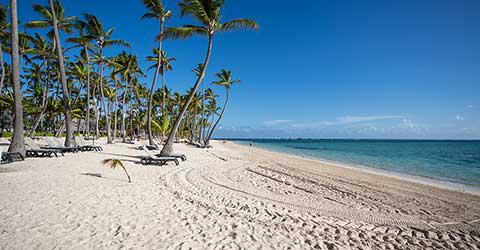
At A Glance
- Because this island is located outside of the Caribbean hurricane belt, it's a great option for a vacation if you're looking to go somewhere during the fall months. It does not have the threat of most Caribbean Islands that your trip will be cancelled or ruined by an unexpected storm.
- There are some rules of etiquette that should be followed while you're vacationing here. In particular, beach clothes on generally only worn when you're on the beach. If you're dining in a nice restaurant, they typically do not allow you to wear jeans. Greetings are important here as well so make sure you appropriately greet somewhere upon meeting them, and always ask before you take a picture of someone.
- Aruba does not have a national airline. Some of the more popular airlines that connect this island to the United States include American Airlines, AirTran, United, and US Airways.
- This is a relatively small island and public transportation is decent. It is often not necessary to rent a car during your time here. If you do decide you'd like to rent a car, make sure you go with a reputable agency. Many car rental companies, even the larger chains, often rent out older vehicles that have a high number of miles on them and are not in the best condition. Do check the condition of the vehicle before you take it off of the rental agency's parking lot.
- If you're hoping to do some shopping there are plenty of opportunities around. Many of the shops do close during the lunch time hour, however. It is not uncommon for them to close on Sundays as well, so do plan your shopping schedule in advance so that you have the highest number of options available to you.
- You'll find a good number of American restaurant chains around the island, particularly near some of the more touristy resort areas. They are also somewhat common in the downtown parts of the island. There are some good, high end restaurants near some of the resorts but others vary dramatically in quality. Read some reviews ahead of time to make sure you're going to one of the more reputable restaurants. Local restaurants are also a great option where you can enjoy some cheaper, local fare and have a more unique and authentic experience.
Top Tourist Attractions
Popular foods.
We've been gathering travel costs from tens of thousands of actual travelers since 2010, and we use the data to calculate average daily travel costs for destinations around the world. We also systematically analyze the prices of hotels, hostels, and tours from travel providers such as Kayak, HostelWorld, TourRadar, Viator, and others. This combination of expenses from actual travelers, combined with pricing data from major travel companies, gives us a uniqe insight into the overall cost of travel for thousands of cities in countries around the world. You can see more here: How it Works .
Subscribe to our Newsletter
By signing up for our email newsletter, you will receive occasional updates from us with sales and discounts from major travel companies , plus tips and advice from experienced budget travelers!

Search for Travel Costs
Some of the links on this website are sponsored or affiliate links which help to financially support this site. By clicking the link and making a purchase, we may receive a small commission, but this does not affect the price of your purchase.
Travel Cost Data
You are welcome to reference or display our travel costs on your website as long as you provide a link back to this page .
A Simple Link
For a basic link, you can copy and paste the HTML link code or this page's address.
Travel Cost Widget
To display all of the data, copy and paste the code below to display our travel cost widget . Make sure that you keep the link back to our website intact.
- Privacy / Terms of Use
- Activities, Day Trips, Things To Do, and Excursions
- United States Australia Canada France --> Germany --> Holland --> India Japan --> Ireland --> Malaysia --> Mexico --> New Zealand Philippines --> Singapore Spain --> UAE United Kingdom Other countries Global
- Profile -->
- My Rates -->
- Search Rates
Currency in Aruba AWG - Things to know
Foreign exchange guide to Aruba and the Aruban florin

What's in this Aruba currency guide?
- Currency Facts
- Travel Money Rates
- Travel Tips
USD/AWG Market Data
- Historic exchange rates
- Send Money to Aruba
- Expat & Business Tips
- Send to -->
What currency is used in Aruba?
The official currency of Aruba (country code: AW) is the Aruban florin , with symbol ƒ and currency code AWG.
Loading rates...

Things to know about the Aruban florin
The currency code "AWG" refers to the Aruban florin, which is the official currency of Aruba. It is represented by the symbol "ƒ" and is abbreviated as AWG. The physical currency consists of coins and banknotes. The coins come in denominations of 5 cents, 10 cents, 25 cents, and 50 cents. The banknotes come in denominations of 5 florins, 10 florins, 25 florins, 50 florins, 100 florins, and 500 florins.
The banknotes feature images of famous Aruban historical figures, such as Queen Beatrix and Prime Minister Jan Peter Balkenende. The design of the currency is constantly being updated, so the physical appearance of the coins and banknotes may vary slightly over time.

Travel money for Aruba
Save money and time by Ordering your Aruban florin online from Travelex, you get better rates and can pick up the AWG cash locally or even on travel day at the airport.
Another popular option is to use a Pre-paid Travel Card . Your Debit/Credit Card provider will charge you 2% from market mid-rate, but your bank may also charge an extra 3% as an “Overseas Transaction Charge” plus “Overseas ATM” fees for withdrawing cash.
For card purchases if offered a choice of currencies always select to Pay in Aruban florin otherwise you may get much worst exchange rates.
Travel Ideas and Money Tips for Aruba

Aruba is a Caribbean island located north of Venezuela. It is a constituent country of the Kingdom of the Netherlands and is located outside the hurricane belt, making it a popular tourist destination known for its sunny weather and white sandy beaches. The island has a population of around 110,000 people and the official languages are Dutch and Papiamento, a Portuguese-based creole language.
What currency to use in Aruba?
The currency is the Aruban florin. The economy of Aruba is based largely on tourism, with the island attracting millions of visitors each year. It is also home to a number of natural attractions, including Arikok National Park, which covers about 20% of the island and features geological formations, caves, and wildlife.

Travel tips for Aruba.
Pack light: Aruba has a tropical climate with temperatures averaging around 80-85°F (27-29°C) year-round. Light, breathable clothing is recommended.
Bring sunscreen and insect repellent: The sun is strong in Aruba, so be sure to bring sunscreen and reapply it frequently. Insect repellent can also be helpful to protect against mosquito bites.
Stay hydrated: It's important to stay hydrated in the warm, humid climate of Aruba. Bring a water bottle and refill it regularly to avoid dehydration.
Rent a car: Renting a car can be a convenient way to explore the island and visit attractions that are off the beaten path. Just be sure to drive on the right side of the road and observe local traffic laws.
Be prepared for the sun: The sun can be intense in Aruba, so be sure to wear a hat, sunglasses, and protective clothing to shield yourself from the sun's rays.
Respect local customs: Aruba is a diverse island with a rich cultural heritage. It's important to be respectful of local customs and traditions during your visit.
Learn a few phrases in Papiamento: While most people in Aruba speak English, it's always appreciated when visitors make an effort to speak the local language. Learning a few phrases in Papiamento can go a long way in showing your respect for the culture of Aruba.
If you are planning to visit Aruba, there are some things you should keep in mind in order to make the most of your trip. Here are some travel tips for Aruba:
1. Plan your trip in advance. Aruba is a very popular tourist destination, so it is advisable to book your hotel and flight well in advance.
2. Choose the right time to visit. Aruba has two main tourist seasons: the high season, from mid-December to mid-April, and the low season, from mid-April to mid-December. The high season is the busiest and most expensive time to visit Aruba, so if you want to save money, you should visit during the low season.
3. Know what to pack. Aruba has a tropical climate, so you should pack light, loose-fitting clothing and comfortable shoes. Don't forget to pack sunscreen, sunglasses and a hat to protect you from the sun.
4. Bring cash. While most hotels and restaurants accept credit cards, it is advisable to bring cash to pay for taxis and other incidentals.
5. Learn some basic words in Papiamento. Papiamento is the official language of Aruba, but English is also widely spoken. However, learning some basic words and phrases in Papiamento will help you to communicate with the locals.
The below interactive chart displays the USD/AWG change and UP 📈 DOWN 📉 trends over the past 1 Year.
Manage My Rates
Frequently Asked Questions
What currency should i use in aruba.
The domestic currency in Aruba is the Aruban florin .
What is the Aruban florin currency code and symbol?
Which countries use the aruban florin.
It is the domestic currency in Aruba.
Is the Aruban florin a closed currency?
No, the Aruban florin is freely available and convertible. See guide: What is a closed currency?
What are equivalent amounts of USD and AWG?
Here are some popular conversion amounts for USD to AWG (US dollar to Aruban florin)*.